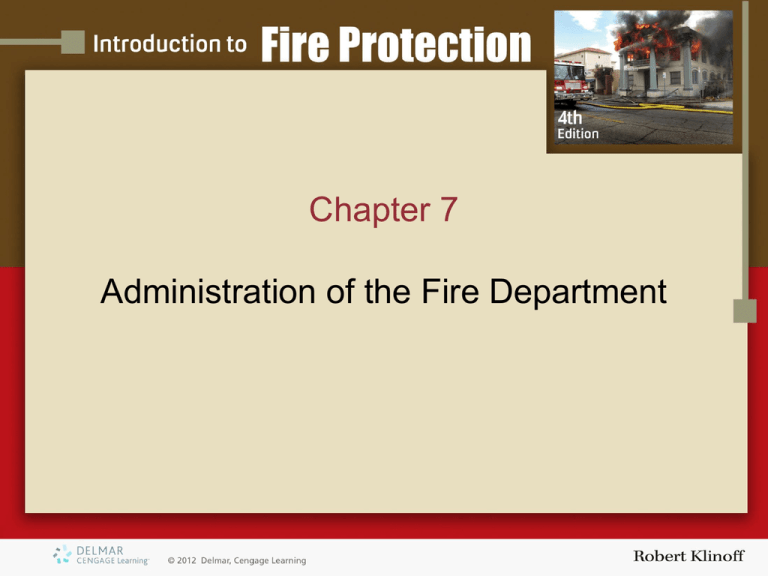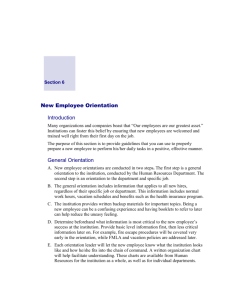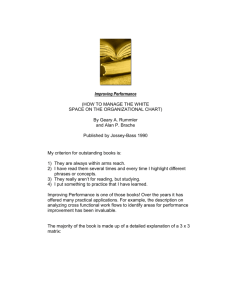Unit 1 Safety Issues
advertisement

Chapter 7 Administration of the Fire Department Introduction • The fire chief must balance the needs of the community and the department with the resources available • Personnel must be properly led and supported in performing their functions • Administrative staff perform their duties to ensure that the personnel of the department are trained, equipped, and supplied with the necessary support services Learning Objectives 1, 4, and 5 Six Principles and Chain of Command Fire Department Organizational Chart PRINCIPLES OF COMMAND • Are general guidelines • Department should serve the needs of its jurisdiction • Used in both emergency and non-emergency organizations • Divided into six areas Learning Objectives 1, 4, and 5 Six Principles and Chain of Command Fire Department Organizational Chart UNITY OF COMMAND • Each person has one boss • Everyone has a clear understanding of who is the supervisor • NIMS is based on unity of command structure • Violation of unity of command leads to confusion Learning Objectives 1, 4, and 5 Six Principles and Chain of Command Fire Department Organizational Chart CHAIN OF COMMAND • Formal path of communication though the organization • Communication flows from top up and bottom down • Cannot be violated unless extreme circumstances Learning Objectives 1, 4, and 5 Six Principles and Chain of Command Fire Department Organizational Chart SPAN OF CONTROL • Can effectively only supervise a certain number of personnel • Effective span is considered three to seven • Decisions dispersed through chain of command • Prevents information overload Learning Objectives 1, 4, and 5 Six Principles and Chain of Command Fire Department Organizational Chart DIVISION OF LABOR • Work divided into specific areas • Apply most appropriate resources • Determine responsibility for completion • Base on area, skill, and complexity • Avoids duplication of effort Learning Objectives 1, 4, and 5 Six Principles and Chain of Command Fire Department Organizational Chart DELEGATION OF AUTHORITY • Manager must delegate authority to subordinates • Supervisor must ensure proper training received • Responsibility is still manager’s • Person assuming responsibility must ensure the function is going to be performed Learning Objectives 1, 4, and 5 Six Principles and Chain of Command Fire Department Organizational Chart EXCEPTION PRINCIPLE • Person delegating authority wants to be informed of situations of major importance • Certain situations arise that the supervisor needs to know about • Personnel matters, major incidents, or incidents involving major expense to the department Learning Objective 2 Six Components of the Management Cycle MANAGEMENT CYCLE • Problem-solving process to accomplish goals and objectives • Objectives must be specific, measurable, attainable, Realistic, and timely Learning Objective 2 Six Components of the Management Cycle PLANNING • Determining objectives and how to achieve them • Requires the use of policies Course or method of action • Procedures Particular way of accomplishing something Learning Objective 2 Six Components of the Management Cycle ORGANIZING • Done after planning • Managers bring together essential resources • Framework is chain of command and table of organization • Manager determines if positions can be filled Learning Objective 2 Six Components of the Management Cycle STAFFING • The assignment of resources to the needs • Determine adequate staffing • Large departments may have rapid intervention teams • Effective fire prevention requires enough personnel assigned to that function Learning Objective 2 Six Components of the Management Cycle DIRECTING • Guiding and supervising efforts • Accomplished through: Rules Standard operating procedures Job descriptions Assigned duties Learning Objective 2 Six Components of the Management Cycle CONTROLLING • Determining if organization is working toward goals • Discrepancies require corrective actions • Largest control is the annual budget • Financial officer will keep fire chief up to date on yearly budget Learning Objective 2 Six Components of the Management Cycle EVALUATING • Determining whether goals and objectives are being met • Must be measurable and attainable • Evaluation is both internal and external • Must be carried out objectively • Is an ongoing process Learning Objective 3 Four Methods of Communication FOUR BASIC METHODS • Face to face Most likely to be understood • Radio/telephone • Written • Electronic Learning Objective 6 Identify Different Fire Department Types FIRE DEPARTMENT TYPES • Type depends on needs and resources • Vary in size • Increase in size, and increase in complexity • More than 30,000 fire departments across the United States involving 1.2 million firefighters Learning Objective 6 Identify Different Fire Department Types VOLUNTEER FIRE DEPARTMENTS • First departments in the U.S. • Preliminary first step in fire service • Common paid position in a volunteer department is a driver • Not predetermined how many personnel will arrive at the scene Learning Objective 6 Identify Different Fire Department Types COMBINATION FIRE DEPARTMENT • Large part of staff is paid • Volunteers cover station when crew is on assignment • Concept provides a force of reserves • Reserves gain training • Department gains personnel Learning Objective 6 Identify Different Fire Department Types PUBLIC SAFETY DEPARTMENT • Police and fire departments are under same department head • Personnel are cross trained • Increased productivity Learning Objective 6 Identify Different Fire Department Types CAREER FIRE DEPARTMENTS • All personnel are paid a salary • Too large to be performed by volunteers • Jurisdiction has control over personnel • Requires expert management Policies and goals Learning Objective 6 Identify Different Fire Department Types INDUSTRIAL FIRE BRIGADES • Manufacturing, refinery, or other location • Personnel hired by the company CONTRACT FIRE PROTECTION SERVICE • Private-sector companies • Service by contract or subscription Learning Objective 7 Ranks and Their General Responsibilities LAYERS OF MANAGEMENT • Deputy chief • Battalion or district chief • Company officer Learning Objective 8 Customer Service, One Department Concept, Team Building, and Incident Effectiveness FIRE CHIEF ATTRIBUTES • Educated in public or fire administration Advanced education, master’s degree preferred • Ability to communicate • Needs to be a diplomat Interpret wishes of governing body Learning Objective 8 Customer Service, One Department Concept, Team Building, and Incident Effectiveness CUSTOMER SERVICE • Public is the customer Customer’s needs must be met ONE DEPARTMENT CONCEPT • Standardization Same procedures throughout the jurisdiction Learning Objective 8 Customer Service, One Department Concept, Team Building, and Incident Effectiveness TEAM BUILDING • Willing to work together Each shift able to support the other INCIDENT EFFECTIVENESS • Ability to function quickly and efficiently Summary • We have looked at the importance of administration at all levels in accomplishing the mission of the fire department • Administration is made up of people performing according to widely accepted concepts and standards • Depending on the size of the department and its needs, the organization of the administration can vary widely • The most important point is that without the support of administrative staff, the line would not function







